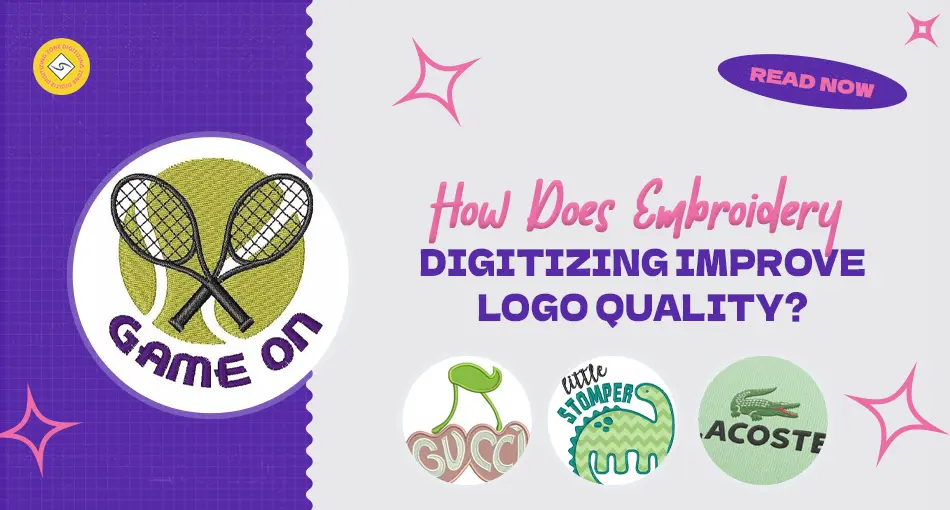In the world of branding and design, the logo is the face of your business. It’s the symbol that represents your company, conveying its identity, values, and professionalism. Therefore, the quality of a logo is crucial in establishing a strong brand presence. While traditional methods like logo printing and screen printing are commonly used, embroidery digitizing has emerged as a superior technique for enhancing logo quality. This advanced method allows businesses to transform their logos into high-quality, long-lasting embroidered designs that add a touch of sophistication and durability.
In this article, we’ll explore how embroidery digitizing improves logo quality, why it’s an excellent option for businesses, and how it compares to other methods like logo printing and screen printing.
What is Embroidery Digitizing?
Embroidery digitizing is the process of converting a logo or artwork into a digital format that embroidery machines can read. This process involves using specialized software to map out how the logo will be stitched, including details such as stitch type, direction, and color. Once digitized, the design can be embroidered onto a wide range of materials, including clothing, hats, bags, and more.
Unlike screen printing or logo printing, which involves transferring ink onto fabric, embroidery digitizing creates a raised, textured image using threads. This method not only enhances the visual appeal of the logo but also makes it more durable and resistant to wear and tear.
Why Embroidery Digitizing Elevates Logo Quality
1. Precision and Detail
One of the primary reasons embroidery digitizing improves logo quality is the precision it offers. The digitizing process allows designers to map out even the smallest details of a logo, ensuring that the final product is an accurate and faithful representation of the original design. This is particularly important for logos with intricate patterns or multiple colors, where precision is key to maintaining the integrity of the design.
In contrast, methods like screen printing or logo printing may struggle to capture the fine details of a logo, especially when it comes to small text or intricate lines. With embroidery digitizing, the threads used in the embroidery process can be carefully controlled to ensure that every element of the logo is clearly defined.
2. Durability and Longevity
Logos that are embroidered through the digitizing process are much more durable than those produced through traditional logo printing or screen printing. The threads used in embroidery are resistant to fading, cracking, and peeling, ensuring that the logo remains vibrant and intact even after multiple washes and years of use. This makes embroidery digitizing an ideal option for businesses looking to create long-lasting logos for uniforms, promotional items, and branded merchandise.
While screen printing is also durable to some extent, it is prone to cracking and fading over time, especially on fabrics that are frequently washed or exposed to the elements. On the other hand, embroidered logos are stitched directly into the fabric, making them much more resilient.
3. 3D Texture and Visual Appeal
Embroidery adds a unique 3D texture to logos, giving them a more tactile and premium feel. This raised effect is something that logo printing and screen printing simply cannot replicate. The textured nature of embroidered logos gives them a luxurious appearance, making them ideal for businesses that want to convey a high-end, professional image.
For example, embroidered logos on corporate uniforms or promotional items like caps and jackets instantly stand out due to their visual depth. The texture also makes the logo more eye-catching, which can help draw attention to your brand in crowded environments.
4. Versatility in Material Choice
Another advantage of embroidery digitizing is its versatility in terms of the types of materials it can be applied to. Unlike logo printing and screen printing, which work best on flat, smooth surfaces, embroidery can be applied to a wide range of fabrics and textures. This includes materials like cotton, denim, leather, and even fleece.
This versatility makes embroidery digitizing an excellent choice for businesses that want to brand items like jackets, hats, bags, or other accessories that are made from different types of fabric. No matter the material, the embroidered logo will maintain its quality and durability.
5. Customization Options
Embroidery digitizing also offers more customization options compared to traditional printing methods. With embroidery, businesses can choose from a wide range of thread colors, thicknesses, and styles to create a truly unique logo. For example, businesses can opt for 3D puff embroidery to give their logo an even more pronounced, raised effect.
Additionally, specialty threads like metallic or glow-in-the-dark can be used to make the logo stand out even more. These customization options allow businesses to create logos that not only look great but also align with their brand’s aesthetic and personality.
How Embroidery Digitizing Compares to Other Methods
Embroidery vs. Screen Printing
Both embroidery digitizing and screen printing are popular methods for logo application, but they offer different advantages depending on the business’s needs.
Screen printing is a cost-effective option for large production runs and works well for logos with vibrant colors and simple designs. However, it lacks the durability and texture that embroidery digitizing provides. Over time, screen-printed logos can fade, crack, or peel, especially when exposed to frequent washing or harsh conditions.
In contrast, embroidered logos maintain their quality over time, even after extensive use. The added texture also gives embroidered logos a more premium appearance, making them ideal for high-end branding or items that require a professional look, such as corporate uniforms or promotional merchandise.
Embroidery vs. Logo Printing
Logo printing typically refers to methods like heat transfer or sublimation printing. Where the logo is printed directly onto the fabric. Like screen printing, logo printing is a cost-effective solution for mass production, especially for items like t-shirts or promotional giveaways.
However, logo printing lacks the durability and visual appeal of embroidery digitizing. Printed logos are more prone to wear and tear, and the ink can fade or crack over time. Additionally, logo printing does not offer the same level of customization as embroidery. While printed logos can be vibrant, they don’t have the tactile quality that embroidered logos provide.
The Embroidery Digitizing Process: How it Works
1. Preparing the Logo
The first step in the embroidery digitizing process is to prepare the logo. The logo must be in a high-resolution format, such as a vector file, to ensure that it can be accurately digitized. The digitizer will then use specialized software to map out the design. Specifying details such as stitch direction, thread color, and stitch type.
2. Pathing and Stitch Types
Once the logo is prepared, the digitizer will plan the path that the embroidery machine will follow. This includes determining the order in which different parts of the logo will be stitched, as well as choosing the appropriate stitch types. Common stitch types include satin stitches for smooth lines and fill stitches for larger areas of the design.
3. Test Stitching
Before the final production run, a test stitch is usually done to ensure that the logo looks as expected when embroidered. This test allows the digitizer to make any necessary adjustments to the design. Such as changing the stitch direction or adjusting the thread tension.
4. Final Production of embroidery digitizing
Once the test stitch is approved, the logo is ready for full production. The embroidery machine will follow the digitized design to stitch the logo onto the desired fabric, creating a high-quality, durable, and visually appealing logo.
Best Practices for Embroidery Digitizing
To ensure the best possible results when digitizing a logo for embroidery. There are several best practices to keep in mind:
1. Simplify Complex Designs
While embroidery can capture a high level of detail, overly complex designs may not translate well onto fabric. Simplifying the logo by removing small text or intricate patterns can help ensure clarity.
2. Choose Bold Colors
Embroidery threads come in a wide range of colors, but bold, high-contrast colors tend to work best. Light colors on dark fabrics, or vice versa, help the logo stand out.
3. Select the Right Material
Different fabrics require different embroidery techniques. For example, thicker fabrics like denim or fleece may require a different stitch density compared to lighter materials like cotton. Working with an experienced digitizer can help ensure that the logo is optimized for the specific fabric.
4. Adjust for Scale
Logos that are embroidered onto smaller items, like hats or pockets, may need to be adjusted to ensure that the design remains clear and legible.
Conclusion: Why Choose Embroidery Digitizing?
In summary, embroidery digitizing is an excellent option for businesses looking to improve the quality of their logos. With its precision, durability, and customization options, embroidery offers several advantages over traditional methods like logo printing and screen printing. Whether you’re creating uniforms, promotional items, or corporate apparel. An embroidered logo can help your brand stand out and make a lasting impression.
At Digitizing Zone, we specialize in providing high-quality embroidery digitizing services that turn your logo into a stunning, durable design. Contact us today to learn more about how we can help elevate your brand through custom embroidery.
For more information, visit our website or follow us on social media for the latest updates on our services.


